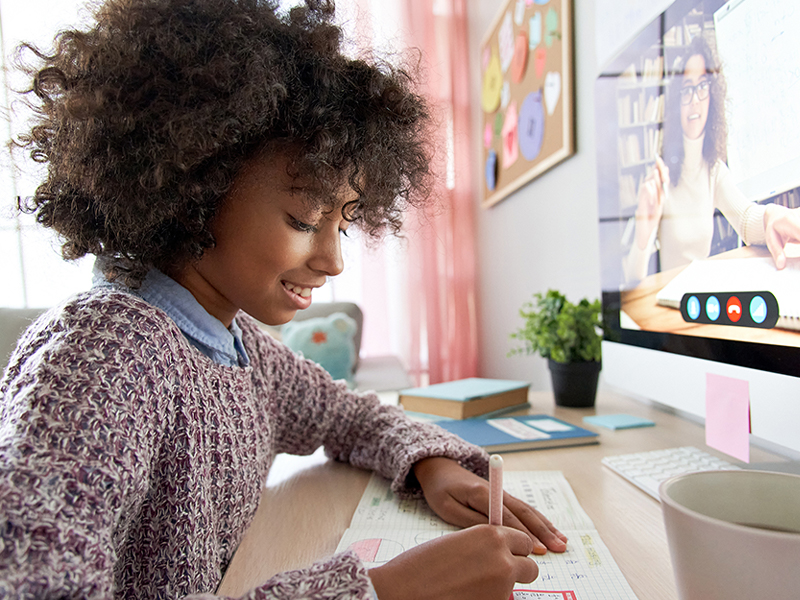March marks one full year of living through the pandemic, with its frightening medical problems and daunting calls for parents to take a greater role in their children’s education. For the last 12 months, parents have struggled to make the most of the less-than-ideal situation of virtual learning for their children.
As time has passed, educators have come to realize that, despite their best efforts, students have not been learning at their peak level in virtual schooling. Perhaps this is because every student is learning the exact educational materials at the same level as their peers. Dr. Macke Raymond, director of the Center for Research on Education Outcomes at Stanford University, suggests this “one-size-fits-all fixed learning will not be effective in reaching the needs of students across the country.”
The United States Department of Education (ED) believes a more effective way to help students navigate virtual learning is through personalized learning, “an educational approach that tailors learning experiences to each student’s strengths, needs, skills and interests,” according to its Office of Educational Technology.
Like “learning pods,” “personalized learning” has a broad, multifaceted definition and multiple methods for implementing it across different educational institutions. In some cases, personalized learning is a modified classroom approach that combines elements of the gifted program in which learners receive differentiated materials and the Montessori method of learning in which teachers are seen as facilitators in a student-centered environment.
Arlington Public Schools, for example, has a vision “to cultivate engaging environments that create relevant and personalized learning experiences for all learners … [and] educational experiences that are specifically tailored to the needs of each individual learner.” By contrast, Montgomery County Public Schools incorporates personalized learning only as part of its Alternative Education Program for at-risk middle and high school students.
In other cases, personalized learning relies on technology to help students advance with their studies at a self-directed pace. Dr. Raymond sees this type of personalized learning as a viable way to help students address the uncertainties of virtual learning during the pandemic. She notes: “New approaches are needed. We need new and different ways of using educators and teachers in the mix. We need to assess what students know. We have to have a sense of where students are.”
A strong proponent of the self-directed personalized learning theory is Dr. Rebecca Klemm, founder of local nonprofit NumbersAlive!, who has been recording simple visual math videos in parks across the District of Columbia, hoping to spark thoughtful questions and conversations about math. Dr. Klemm’s goal is to have children and parents train themselves to look at everyday situations “by investigating patterns in the living environment as situations arise …[in order to gain] discovery … [and] encourage mathematical thinking.” ED suggests parents help their children with virtual learning struggles by downloading two new educational programs that follow the self-directed personalized learning approach through innovative digital maps and GPS-based infrastructure.
Teach to One Roadmaps
Teach to One Roadmaps (Roadmaps), released in late September 2020, seeks to address math skill inequities among students through “a custom-tailored path of post-grade skills to catch up and get ahead,” says CEO Joel Rose.
In 2011, Rose founded nonprofit New Classrooms Innovation Partners, Inc. and spent 10 years working on a technological solution with a philosophy known as “Tailored Acceleration [which] … allows for each and every student to follow a pathway created just for them – a unique blend of on-grade skills and building blocks from previous years.”
Roadmaps is available for use on a desktop, mobile phone and tablet. Geared to students in fourth through eighth grades and students learning algebra, Roadmaps offers users a free version, as well as paid home and plus plans. It is suggested that parents start their children with the free diagnostic assessment that helps determine which skills a student knows and what they need to learn to be in line with their grade.
Once the diagnostic is finished, students can take math classes containing “a comprehensive set of math skills they must master in order to achieve grade-level proficiency.” After completing each math lesson, the student’s progress is updated and their “roadmap” showing where the student has been and where they’re going refreshes based on student progress. Learn more here: teachtoone.org/roadmaps.
Gooru Navigator for Learners
Like Roadmaps, Gooru Navigator for Learners (Navigator) is an educational app that provides a similar roadmap to students, showing them where they’ve been and where they need to go to advance in their studies.
Navigator is free, offering a full suite of educational lessons on a variety of subjects for students to complete digital and offline activities, including essay writing and creation of presentations. Navigator describes itself as an educational GPS, helping students identify where they are, look for a destination and explore the learning journey through a visual skyline.
Nonprofit Gooru developed Navigator using open-source data to offer learning module suggestions to its users. According to its founder and CEO, Dr. Prasam Rad, “the student downloads the app and picks where they want to go. What is the skyline of the student? These are competencies that the student has to learn. It indicates [the presence of any] learning gaps.”
By using the Navigator app, students control the pace of what they want to see and learn. They simply pinch the screen to view their horizon, or visual view, of lessons they have mastered and those they still need to learn.
Its main component is Math Navigator, which provides comprehensive math course content for students in grade 2 through high school. It also offers Science Navigator, which provides content in earth and space sciences, life sciences, physical sciences and science and engineering practices for students in sixth, seventh and eighth grades. Learn more here: gooru.org/about/navigator/navigator-for-learners


